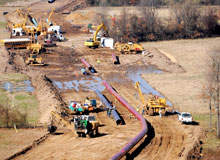
Midcontinent Express pipeline is a 500-mile (804.67km) natural gas system in the US. It has a capacity of 1.25 billion cubic feet of gas each day (bcf/d). Capacity of the pipeline can be expanded up to two bcf/d if needed.
The Federal Energy Regulatory Commission approved the project in September 2007. Construction of the pipeline started in September 2008 and was carried out in two phases.
The pipeline was completed in August 2009. Interim services began on a 266-mile long section of the pipeline in June 2009. A total investment of $1.3bn was made in the project.
Midcontinent Express Pipeline (MEP), a 50/50 joint venture between Energy Transfer Partners and Kinder Morgan Energy Partners, executed the project. Kinder Morgan was responsible for construction and operation of the pipeline.
Reach of the MEP and interconnections with natural gas pipelines
The pipeline originates at Oklahoma and extends across several states, including to north-east Texas, northern Louisiana, central Mississippi and Alabama in the US. It consists of three sections – a 266-mile section with a 42in diameter, a 202-mile section with 36in diameter and a 39-mile section with 30in diameter. It also includes a 6.5km long 16in diameter lateral section in Louisiana.
Four compressor stations have been built in Lamar County, Atlanta, Perryville and Vicksburg. One booster station with 111,420hp of compression capacity in Delhi, Louisiana is part of the pipeline. Meter stations, mainline valve, pig launcher and receivers and other related facilities are also part of the pipeline system.
The pipeline consists of two gas transport capacity zones. Zone one has a capacity to carry up to 1.25bcf/d and zone two can carry up to 0.84bcf/d.
The pipeline interconnects with 13 natural gas pipelines owned by various companies, including Enogex, Natural Gas Pipeline Company of America, Energy Transfer Partners, Texas Gas Transmission, ANR Pipeline Company, CEGT, Columbia Gulf Transmission Company, Texas Eastern Transmission, Southern Natural Gas Company, Tennessee Gas Pipeline Company, Destin Pipeline Company and Transco.
Workers and machinery needed to construct the vast pipeline
The MEP was laid parallel to the existing pipeline or electric transmission right-of-ways to reduce the impact on the environment, communities and landowners. Construction was divided into different spreads, with each spread being laid by one contractor.
Automatic welding machines were used to weld pipe segments together. The segments were tested and inspected, after which they were laid in 7-9ft deep trenches with a cover of 4ft.
Nearly 6,000 workers were involved in the construction of the pipeline. Construction was carried out simultaneously on various spreads. One 74-mile spread required about 300 excavators, 80 side booms and 70 bulldozers.
Contractors linked to Midcontinent Express Pipeline’s US project
Alliance Engineering was responsible for the engineering, design and project management of eight meter stations.
Edgen Murray supplied 17,000t of 30in, 36in and 42in pipes for the project. Toromont Industries supplied booster compression equipment. CRC-Evans Automatic Welding provided welding equipment.
Contractors involved in the construction of different spreads of the pipeline were MG Dyess, North Houston Pole Line, Blackwell Enterprises and Henkels & McCoy.
Benefits of the Midcontinent Express domestic gas pipeline
Energy demand has been growing steadily in the US. Demand for natural gas, especially, is expected to increase and reach 26.1 trillion cubic feet a day by 2030.
The main sources of natural gas supply are imports from Canada and Mexico, LNG imports and domestic production.
By 2030, domestic natural gas production is expected to satisfy the majority of the demand. Natural gas production from Barnett Shale and Bossier Sands in Texas, Fayetteville Shale in Arkansas and Woodford Shale in Oklahoma will be major contributors to this demand.
The MEP pipeline strengthens the energy infrastructure in the US to meet this demand. It helps in delivering natural gas to the Midwest, Northeast and Southeast. It also boosts the economic growth in these regions and provides an alternative route for natural gas transport during hurricanes and other natural disasters.



